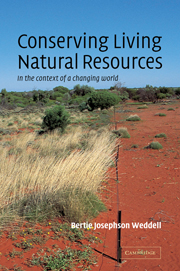Book contents
- Frontmatter
- Contents
- Preface
- Introduction: Balance and flux
- Methodology: Getting the information we need to manage living natural resources
- Part I Management to maximize production of featured species – a utilitarian approach to conservation
- Part II Protection and restoration of populations and habitats – a preservationist approach to conservation
- Part III Management to maintain processes and structures – a sustainable-ecosystem approach to conservation
- 11 Historical context – pressures to move beyond protection of species and reserves
- 12 Central concepts – the flux of nature
- 13 Techniques – conserving processes and contexts
- 14 Techniques – including people in the conservation process
- Postscript
- Appendix: Scientific names of organisms mentioned in the text
- Index
12 - Central concepts – the flux of nature
Published online by Cambridge University Press: 05 June 2012
- Frontmatter
- Contents
- Preface
- Introduction: Balance and flux
- Methodology: Getting the information we need to manage living natural resources
- Part I Management to maximize production of featured species – a utilitarian approach to conservation
- Part II Protection and restoration of populations and habitats – a preservationist approach to conservation
- Part III Management to maintain processes and structures – a sustainable-ecosystem approach to conservation
- 11 Historical context – pressures to move beyond protection of species and reserves
- 12 Central concepts – the flux of nature
- 13 Techniques – conserving processes and contexts
- 14 Techniques – including people in the conservation process
- Postscript
- Appendix: Scientific names of organisms mentioned in the text
- Index
Summary
Wherever we seek to find constancy, we discover change. … The old ideas of a static landscape, like a single musical chord sounded forever, must be abandoned, for such a landscape never existed except in our imagination. Nature undisturbed by human influence seems more like a symphony whose harmonies arise from variation and change over every interval of time. We see a landscape that is always in flux, changing over many scales of time and space, changing with individual births and deaths, local disruptions and recoveries, larger scale responses to climate from one glacial age to another, and to the slower alterations of soils, and yet larger variations between glacial ages.
(Botkin 1990:62)We have seen that utilitarian and preservationist resource managers tend to envision nature as moving toward equilibrium. In this view, ecological systems are seen as closed and self-regulating. Like a pendulum, they return to their original state if they are altered. This balance-of-nature view generated many important insights in at least three areas of inquiry. First, when biologists looked at populations from this perspective, they focused on those that were in equilibrium with their resources, that is, populations near carrying capacity (Chapter 2). Intraspecific competition and density-dependent population growth were elucidated in this context. Second, community ecologists viewed communities as proceeding toward a stable climax and focused their attention on disturbances that set back succession. This allowed ecologists to distinguish between the existing plant community on a site and the potential vegetation at that location.
- Type
- Chapter
- Information
- Conserving Living Natural ResourcesIn the Context of a Changing World, pp. 301 - 326Publisher: Cambridge University PressPrint publication year: 2002



